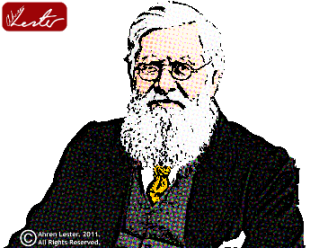 |
| Professor Kevin Boyle. Photo from The Guardian. |
Month: November 2011
Alfred Russel Wallace goes all ‘Pop Art’
For those who know anything about the diverse (and often controversial) thinking of Alfred Russel Wallace will know that often he was very forward thinking from the point of view of modern eyes.
As well as co-discovering the theory of evolution by natural selection with Charles Darwin and helping develop the field of biogeography he supported, amongst other things, conservationism and sustainability, ‘equality of opportunities’ for all and vegetarianism. He was often a pioneer with concerns which are remarkably contemporary including his writings on the possibility of life on Mars which, as Professor Charles H. Smith notes, is now seen as one of the ‘pioneer works in the field of exobiology’ (although whether he realised that less than 100 years after his death that simulations were being run to travel to the far-flung planet).
It was thinking about this ‘modern’ side of Wallace when I realised that very few pictures reveal this potential relevancy of Wallace.Victorian and Edwardian photographs always, quite naturally, look rather dated and often rather stuffy. More often than not, this misses the colour and vitality of Wallace’s long life and work.
If a picture paints a thousand words, I thought, maybe I should have a go at translating this for a modern audience. I thus set about bringing a portrait of Wallace up to date and. hopefully, make it more eye-catching to those I talk to in regards to Wallace.
 |
| Alfred Russel Wallace: the co-discoverer of the theory of evolution by natural selection |
I thus had a go at creating a ‘Pop Art’ image of Wallace using as my template one of my favourite images of Wallace. Although this style of image has been used very often (almost to the extent of becoming a cliche) I thought the end result was more than good enough for starters. Please do tell me what you think.
Letters between Wallace and the Australian conchologist, Charles Hedley, published by Australian Museum
Originally published in a shortened form on the Wallace Fund website.
The Australian Museum based in Sydney has put electronic copies of two letters from AR Wallace to the highly respected conchologist, Charles Hedley, on their website.
The letters, one from July and the other from October 1892, are in response to letters and papers that Charles Hedley delivered to Wallace at his home in Parkstone, Dorset.
 |
| One of the letters between Wallace and Hedley talking about Wallace’s work ‘Island Life’ |
The reference in the later letter of October 1892 regarding the enclosure on the Placostylus (a type of air-breathing land snail) as well as the debate surrounding the ‘land-connection’ between New Zealand and Australia makes it highly likely that the enclosure was Hedley’s ‘The Range of Placostylus; a study in ancient geography’ as Hedley refers to Wallace’s Island Life work and the fact that ‘Australia and New Zealand were formerly connected by a bridge of dry land’ within it (pp. 336-7). Wallace also references his The Geographical Distribution of Animals (1876) within the letter. ‘In the second of these letters,’ explained Vanessa Finney, the Manager of Archives and Records at the Museum on their blog, ‘Wallace hotly disputes Hedley’s theory of the range and distribution of [Placostylus].’
In this letter Wallace also mentions the orchids Hedley encountered and expressed a desire to have some samples of the plant as he was ‘pretty interested’ in this field. He certainly was, and even built an Orchid House at his home in Parkstone, Dorset in the mid-1890s. Unfortunately, the constant attention and intense heat required for these delicate flowers were too much for him and he had to give them up. However, he never lost his passion for these superb flora.
- ‘The Land Molluscan Fauna of British New Guinea’, Proceedings of the Linnean Society of New South Wales, vol. 2 (1891), pp. 384-392
- ‘The Range of Placostylus; a study in ancient geography’, Proceedings of the Linnean Society of New South Wales, vol. 7 (1893), pp. 335-339. [pdf document]
- ‘On the Relation of the Fauna and Flora of Australia to Those of New Zealand’, Natural Science, vol. 3 (1893), pp. 187-191.
- ‘An Enumeration of the Janellidae’, Transactions and Proceedings of the Royal Society of New Zealand, vol. 25 (1892), pp. 156-162 [pdf document]